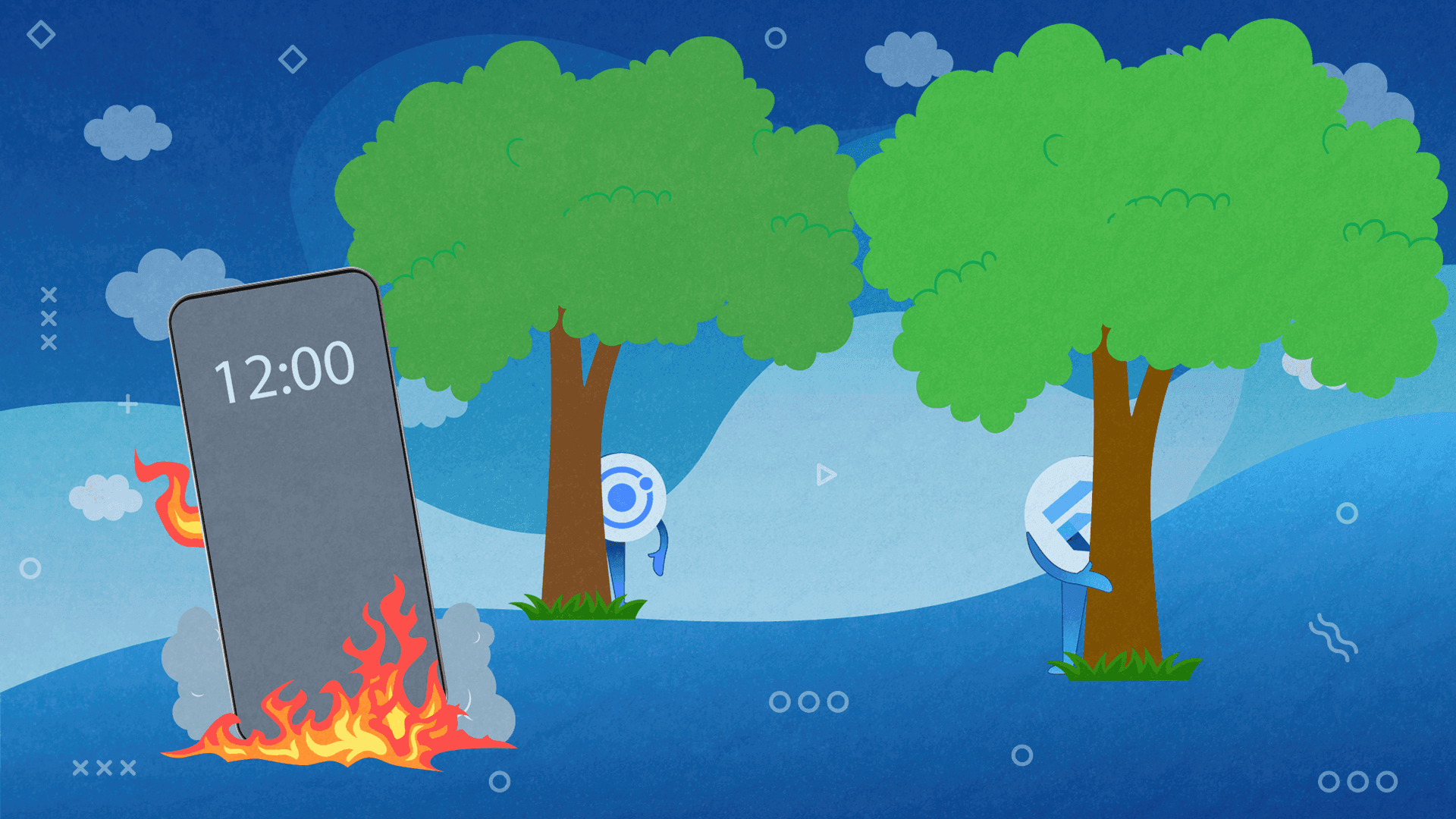Flutter vs Ionic: Which Framework is Better for Building Your Next Mobile App?

Choosing the right framework for your project is never simple. There are too many options to choose from and finding the “best one” requires lots of reading and consulting with experts.
And yet, mistakes still happen.
If you’re planning to invest in the creation of, for instance, a mobile app, you need to be 100% sure which cross-platform development technology fits your business needs and budget.
The mistakes you can make in this phase of the process can put lots of unnecessary roadblocks in front of you that will slow your operations down and make you dread starting to work on your project.
Is There a Fail-Safe Process for Choosing the Right Framework?

When you have a concept in mind and you’re in a stage of comparing frameworks for your project, everything should boil down to the specifics of what you’re looking to build.
You need to factor in all the circumstances and work around that giant, super annoying “it depends” piece of the puzzle that makes it hard to separate the wheat from the calf.
If you don’t have lots of experience doing what you have currently started to work on, that’s often easier said than done.
You can read a lot of content online and talk to people from the industry and still be unsure in which direction to go.
But don’t worry, we at Share It have your back.
As you know if you’ve been reading our blog, we already wrote multiple articles on the subject of cherry-picking the right tool/framework/principle for the right project.
We invest a lot of effort in developing content for our readers that helps them understand the strengths and weaknesses of every framework and puts things in the right perspective (using clear, conversational language).
These last couple of months, we focused hard on Flutter. In addition to providing you, our reader, with a detailed breakdown of what Flutter is and why you care about it, we also wrote a couple of posts that put this open-source tool for developing native apps next to some of its biggest competitors.
On our blog, you can find the following pieces:
Today, we’re adding another entry to this library and putting Flutter shoulder-to-shoulder with Ionic (another framework that’s wildly loved by the mobile dev community).
So, if you’re struggling to find the right framework for your mobile app, maybe this post (along with the two linked above) will help you figure out in which direction you should go.
What is Flutter?
A couple of months ago, we wrote a big post that covers all the important things you need to know about Flutter. You can read it here!
In case you don’t feel like reading another full article right now, we are going to give you a digested version.
Here’s what you need to know about Flutter:
- This is an open-source tool for developing native apps on Android and iOS. It was created and released into the world by Google back in 2018.
- Flutter has two main components: An SDK (Software Development Kit) - a collection of tools that are going to help you develop your applications. This includes tools to compile your code into native machine code (code for iOS and Android); A Framework (UI Library based on widgets) - a collection of reusable UI elements (buttons, text inputs, sliders, and so on) meant to help you personalize your work.
- It has its programming language called Dart.
- Dart was created to replace JavaScript. It is a language for front-end development. Dart can be used for the creation of both mobile and web apps, but it’s primarily used for building mobile apps.
What is Ionic?
Unlike Flutter, Ionic is a concept we didn’t previously cover on the blog. However, this doesn’t mean that we plan to write 6000 words about it in this section.
Just like with the segment above, we’re going to give you a TL;DR version of Ionic so we can move faster down to the actual pros and cons of these two solutions:
- Ionic is an extremely popular name in the mobile development world.
- As you have probably guessed on your own, Ionic is an open-source framework and UI toolkit that makes it possible for developers to create hybrid cross-platform mobile apps.
- The thing that makes Ionic unique is the core principle on which it operates: it uses Webview for mobile instead of using native device elements.
- Ionic uses familiar JavaScript codebases like vanilla JavaScript, Angular, React, or Vue. It is officially integrated with React & Angular.
- Ionic has multiple component presets that provide native functionality.
- The framework is known for providing efficient performance with minimum DOM manipulation. Which sort of means that the framework is often used to alter/improve the front-end part of the job.
How do Flutter and Ionic Compare to One Another?

Both frameworks exist to serve a common purpose: to help easily build outstanding applications with interactive user interfaces. Both frameworks have proven to be useful in enabling that, but there are elements in which they differ from one and another. These differences have the potential to significantly affect what you’re thinking about building and how.
Right off the bat, we have to acknowledge that Ionic utilizes the web platform and holds onto open web standards. When you work with Ionic, regardless of what you’re building (a mobile, web, or desktop app), you’re operating with the exact same code.
With Flutter, it’s different. Flutter uses Dart which immediately puts limitations on what you can do with the same code. Unlike Ionic that uses familiar JavaScript codebases like vanilla JavaScript, Angular, React, or Vue, Flutter provides less range.
However, that doesn’t mean that Flutter is not as good as Ionic.
The Case for Flutter
On the contrary, Flutter just has different use cases. This framework is built for mobile and it delivers on what it’s meant to do. Flutter gives remarkable performance on mobile devices. It simplifies everything and makes it easy for developers to create working mobile apps with very little code.
As we already wrote in the comparison post with Xamarin, Flutter provides developers with the freedom to add changes to their code and immediately see how they perform in real-time. This makes Flutter a great asset for projects where you need to quickly and cheaply build MVPs that you can work off.
The only real downsides of using Flutter are related to UX limitations, Dart (as we explained above), app size, and lack of stability (since Flutter is a relatively new solution, and like all young concepts - some libraries are just not there yet and require more work).
The Case for Ionic
Just like Flutter, Ionic is a framework for building fast and budget-friendly solutions. It helps the time, resources, and effort needed to develop a cross-platform app while giving a native look as well as feel to the app.
The use of a single codebase is a major plus, but, just like Flutter, this framework comes with specific limitations.
Even though Ionic comes with lots of cool plugins, you still have to create your own features which are a drag. Since Ionic doesn’t give developers the option to introduce changes to their code and see how they perform in real-time (a.k.a. Hot-Reloading), every change that the developers introduce kinda derails the speed and efficiency of the entire development process. So, with Ionic, making changes to the code is a lot harder than with Flutter.
With Ionic, you usually get heavy apps. Because Ionic uses WebView for rendering apps, the products you get are slow and sluggish.
So Which One is Better?
As we wrote at the beginning of this post, it all depends on what you’re looking to build. If you have clear business objectives and user requirements, the decision process instantly becomes simple.
It boils down to the use cases. If you’re looking to build quick MVPs, apps with material design, apps that function with OS-level features, that also have a flexible UI with high-level widgets, and vast data integration - our money is on Flutter.
Flutter undeniably provides a better app performance than Ionic. It does not need a bridge of communication between its native modules as native components are available by default. The changes you introduce are quickly processed and visible and you can have as many interactions without making a mess of your development process and missing key deadlines.
If you’re looking to build platform-agnostic solutions, apps with hardware functionality, and high-performing UI/UX - we advise you to choose Ionic over Flutter. It’s clearly a stronger tool for this particular use case.